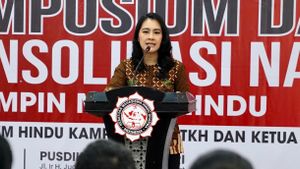JAKARTA - The Pre-Employment Card Program has not only received criticism from workers or workers, but also from business actors. The Indonesian Young Entrepreneurs Association (HIPMI), highlighted several problems in the program that have been implemented by the government. One of them is the absence of relevant measuring tools that are built to increase community productivity.
Chairman of the Finance and Banking Division of BPP HIPMI, Ajib Hamdani, said that the beginning of the emergence of this pre-employment card program departed from Presidential Regulation (Perpres) Number 36 of 2020. The objective is to increase community work with productivity and competitiveness. However, in its implementation, there is no increase in productivity in the Pre-Work Card program.
"The problem is that there is no measuring instrument relevant to the spirit built by this Presidential Decree. When the (businessmen) friends tried sampling, there were those who could and did not. So there was no clear measure of who could enter and what was not included. , "he said, in a video conference with journalists with the theme 'How and Conditions to Become a Pre-Employment Card Partner?', Monday, April 27.
Ajib assessed that not all of the Pre-Employment Card program participants were right on target. This is because there are some who enter as participants but actually don't need them, and still have sufficient money. However, have the opportunity to enter the Pre-employment Card. Because of this, he questions the benchmarks of passing participants.
"There are friends who can then come in. Even though they don't really need it, even though this can't reflect everything. This is first, about how to measure the person who is right (needs) or not," he explained.
Does not guarantee effectiveness
The second problem, said Ajib, was how to measure whether this program was effective or not for the program's training participants. For example, what percentage can get a job after being given training through this Pre-Employment Card program.
"For example, out of 160 thousand people in the first phase, there are actually 30 waves in the future. That's how many percent can then get job opportunities because their skills are upgraded? How many percent later can do business? What percentage does she have yet to get. the opportunity to be professional, to be an employee again or to be in business, "said Ajib.
According to Ajib, the government must answer this measure by including data. Because answering no with numbers only creates debate.
"So we can't argue an opinion with debate either. But a debate will be over when we can come up with numbers," he said.
However, said Ajib, there are other problems that have arisen. Because the government, in this case the Coordinating Ministry for the Economy, is collaborating with a digital platform, this measurement tool cannot be provided mandatory.
"Because after all the digital platform is waiting for input from people who take part in the training, then how do they report it. So how about after the training," he said.
The English, Chinese, Japanese, Arabic, and French versions are automatically generated by the AI. So there may still be inaccuracies in translating, please always see Indonesian as our main language. (system supported by DigitalSiber.id)













